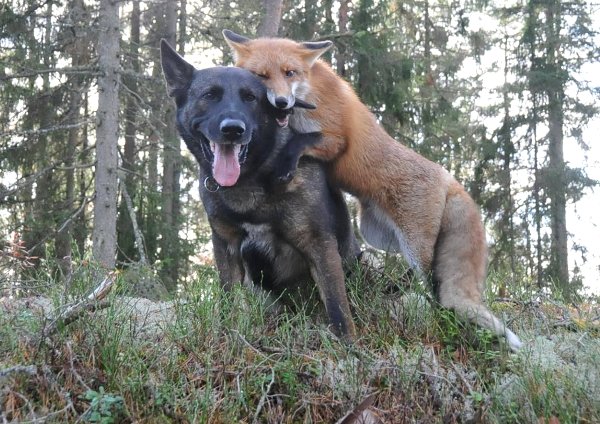A los perros les encanta jugar en la nieve, sobre todo cuando no viven en zonas en las que es habitual que nieve y entonces les parece una novedad: ¡una nueva textura! ¡Pero sí es blandita! ¡Me hundo!¿Pero esto se come?
Pero es importante tener ciertas precauciones porque aunque parezca que está encantado, puede tener sus consecuencias, las más graves son hipotermia, quemaduras por frio en las almohadillas o vómitos por ingesta masiva de nieve o sal.
1. Si permanecemos mucho rato en la nieve hay que retirarle las bolitas que se le van compactando en las patas
2. ¡Ojo! Si caminamos por zonas donde han esparcido sal, hay que lavarle bien las patas al llegar a casa porque sí se las chupa puede provocarse un grave desequilibrio electrolítico por ingesta masiva de cloruro sódico, sufriendo vómitos o diarrea. Pero la sal acumulada en las patas también puede provocar heridas, sequedad o grietas produciéndole gran dolor que le difucultará para caminar.
3. Que no se coma o mastique el hielo, esto también les hace mucha gracia pero puede provocarle vómitos severos o diarrea que nos van a obligar a llevarle al veterinario. Además, si come mucha cantidad, disminuirá la temperatura corporal, que junto con la baja temperatura exterior podría provocarle hipotermia.
4. Si es perro casero, pequeño o no acostumbrado a bajas temperaturas hay que abrigarle, mejor con una prenda reflectante o de un color fuerte que se distinga fácilmente para poder encontrarle si se despista, por ejemplo rojo o naranja. No utilices colores como el blanco, verde o marrón porque se camuflaría con el entorno y sería muy difícil encontrarle en caso de que no se moviera.
5. Si tirita de frio a pesar de estar bien abrigado, llévale a un sitio caliente. Podría sufrir hipotermia, exactamente igual que las personas.
6. Sécale y límpiale bien cuando llegue a casa. Es importante que permanezca bien seco para que no se enfríe. Los perros tardan mucho más en secarse por la cantidad de pelo que tienen.
7. Si tu perro es muy mayor, un cachorro o tiene algún problema de salud, va a sufrir más en condiciones de frio extremo. Valora los riesgos y que un día agradable de nieva no se convierta después en un problema
Además nos preguntaremos ¿como es posible que no sientan frío en las patas? Pues porque las patas tienen un alto contenido de tejido graso que es más aislante y se congela con más dificultad que otros tejidos, además su especial vascularización les proporciona una especie de calentador. Aún así hay que protegerles las patas porque podría sufrir quemaduras por frio:
- Hay productos específicos, aceites o grasas, que aumentan la protección y aislamiento frente al frío, que se extienden sobre las almohadillas.
- Hay botas, pero tardan en acostumbrarse. Es mejor dejarlas para perros que pasen muchas horas en la nieve o que trabajen en ella (trineos, salvavidas).
Dogs love to play in the snow, especially when they do not live in areas where it is common to snow in winter and they think it´s funny: a new texture! it is squishy! I sink! Can I eat it?
But it is important to take precautions because although it seems he is delighted, a long time playing on the snow can have its consequences:
1. If we remain a long time in the snow the snow balls compacted on their legs must be removed.
2. Be careful! If we walk through areas where salt has been spread, it´s necessary to clean the paws and legs when returning back home. If the dog sucks them can cause a serious electrolytic unbalance by massive intake of sodium chloride.
3. Don´t let him to eat snow or chew ice. This is very funny but it may cause severe vomiting and we´ll be forced to take him to the vet.
4. if the dog is small, used to be at home or not accustomed to low temperatures, you have to keep him warm with a reflective or strong color coat to find him easily. Don´t use white, green or brown colors because he can camouflage with the environment and not to see him if he can´t move
5. If the dog shiver with cold despite being wrapped, take him to a warm place. He could suffer hypothermia, exactly the same as people.
6. Dry and clean up well when you get home. It is important to stay dry in order not to cool. Dogs take much more to dry by the amount of hair they have.
7. If your dog is very old, a puppy or has a health problem, he´ll suffer more during extreme cold weather. Assesses the risks and that a nice day of snow doesn´t become a problem later.
In addition we will ask ourselves how it is possible they don´t feel cold in the legs. Paws have a high content of fatty tissue which is more insulating and freezes with more difficulty than other tissues, also its special vascularization provides them with a kind of heater. In spite of that we must protect them:
-There are specific products, oils or fats, which increase the protection and insulation against cold, must be
extended over the paws.
-There are boots, but it takes long to get used. Must be used in dogs that spend many hours in the snow (lifeguard, sled dogs)




























